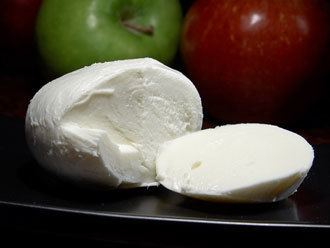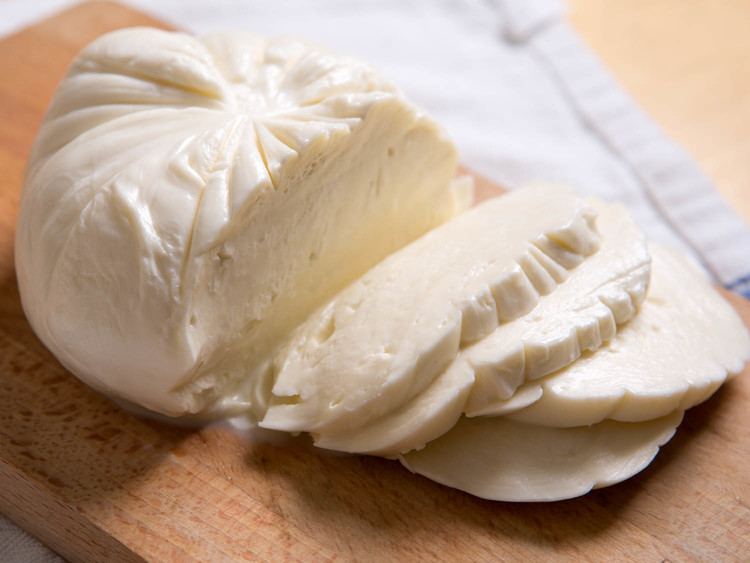Texture Semi-soft Certification TSG 1998 | Pasteurized Sometimes Fat content 22% | |
 | ||
Similar Cheese, Parmigiano‑Reggiano, Pizza, Cheddar cheese, Basil | ||
How to make mozzarella cheese at home
Mozzarella ( /ˌmɒtsəˈrɛlə/; [mottsaˈrɛlla]) is a southern Italian cheese traditionally made from Italian buffalo milk by the pasta filata method. Mozzarella received a Traditional Specialities Guaranteed certification from the European Union in 1998. This protection scheme requires that mozzarella sold in the European Union is produced according to a traditional recipe. The TSG certification does not specify the source of the milk, so any type of milk can be used. In Italy mozzarella made with the milk of the Italian water buffalo is an important variety. The Italian buffalo mozzarella sold as Mozzarella di Bufala Campana is protected under the EU's Protected Designation of Origin scheme and may only be produced in select locations in the regions of Campania, Lazio, Apulia and Molise.
Contents
- How to make mozzarella cheese at home
- How to make mozzarella cheese
- Etymology
- Types
- Variants
- Production
- References
Fresh mozzarella is generally white, but may vary seasonally to slightly yellow depending on the animal's diet. Due to its high moisture content, it is traditionally served the day after it is made, but can be kept in brine for up to a week or longer when sold in vacuum-sealed packages. Low-moisture mozzarella can be kept refrigerated for up to a month, though some shredded low-moisture mozzarella is sold with a shelf life of up to six months. Mozzarella of several kinds is also used for most types of pizza and several pasta dishes, or served with sliced tomatoes and basil in Caprese salad.

How to make mozzarella cheese
Etymology

Mozzarella, derived from the Neapolitan dialect spoken in Campania, is the diminutive form of mozza ("cut"), or mozzare ("to cut off") derived from the method of working. The term is first mentioned in 1570, cited in a cookbook by Bartolomeo Scappi, reading "milk cream, fresh butter, ricotta cheese, fresh mozzarella and milk". An earlier reference is also often cited as describing mozzarella. Historian Monsignor Alicandri, in "Chiesa Metropolitana di Capua," states that in the 12th century the Monastery of Saint Lorenzo, in Capua, offered pilgrims a piece of bread with mozza or provatura. These are locations rather than products and mozza is taken by some to be mozzarella.
Types

Mozzarella, recognised as a Specialità Tradizionale Garantita (STG) since 1996, is available fresh, usually rolled into a ball of 80 to 100 grams (2.8 to 3.5 oz), or about 6 cm (2.4 in) in diameter, sometimes up to 1 kg (2.2 lb), or about 12 cm (4.7 in) diameter, and soaked in salt water (brine) or whey, and other times with citric acid added, and partly dried (desiccated) its structure being more compact, and in this form it is often used to prepare dishes cooked in the oven, such as lasagna and pizza.

When twisted to form a plait mozzarella is called treccia. Mozzarella is also available in smoked (affumicata) and reduced-moisture packaged varieties. "Stuffed mozzarella", a new trend as of 2006, may feature olives or cooked or raw ham, or small tomatoes (pomodorini).
Variants
Several variants have been specifically formulated and prepared for use on pizza, such as low-moisture Mozzarella cheese. The International Dictionary of Food and Cooking defines this cheese as "a soft spun-curd cheese similar to Mozzarella made from cow's milk" that is "[u]sed particularly for pizzas and [that] contains somewhat less water than real Mozzarella".
Mozzarella di bufala campana is a type of mozzarella made from the milk of Italian buffalo raised in designated areas of Campania, Lazio, Apulia, Molise in Italy. Unlike other mozzarellas—50% of whose production derives from non-Italian and often semi-coagulated milk—it holds the status of a protected designation of origin (PDO 1996) under the European Union
Fior di latte (written also as one word), is made from fresh pasteurized or unpasteurized cow's milk and not water buffalo milk, which greatly lowers its cost. Outside Italy "mozzarella" not clearly labeled as deriving from water buffalo can be presumed to derive from cow milk
Mozzarella affumicata means smoked mozzarella.
Ovolini refers to smaller-sized bocconcini, and sometimes to cherry bocconcini.
Low-moisture part-skim mozzarella, widely used in the food-service industry, has a low galactose content, per some consumers' preference for cheese on pizza to have low or moderate browning. Some pizza cheeses derived from skim mozzarella variants were designed not to require aging or the use of starter. Others can be made through the direct acidification of milk.
Production
Mozzarella di bufala is traditionally produced solely from the milk of the domestic buffalo. A whey starter is added from the previous batch that contains thermophilic bacteria, and the milk is left to ripen so the bacteria can multiply. Then, rennet is added to coagulate the milk. After coagulation, the curd is cut into large, 1"–2" pieces, and left to sit so the curds firm up in a process known as healing.
After the curd heals, it is further cut into 3/8"–1/2" large pieces. The curds are stirred and heated to separate the curds from the whey. The whey is then drained from the curds and the curds are placed in a hoop to form a solid mass. The curd mass is left until the pH is at around 5.2–5.5, which is the point when the cheese can be stretched and kneaded to produce a delicate consistency—this process is generally known as pasta filata. According to the Mozzarella di Bufala trade association, "The cheese-maker kneads it with his hands, like a baker making bread, until he obtains a smooth, shiny paste, a strand of which he pulls out and lops off, forming the individual mozzarella." It is then typically formed into cylinder shapes or in plait. In Italy, a "rubbery" consistency is generally considered not satisfactory; the cheese is expected to be softer.
